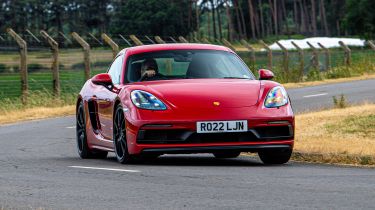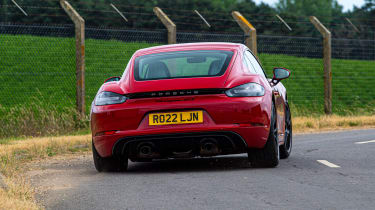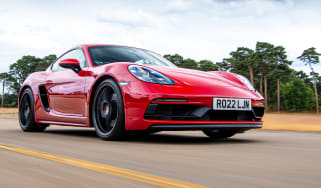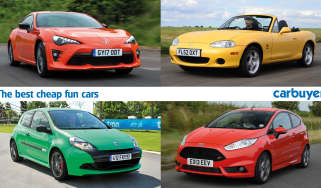Porsche 718 Cayman review - Engines, drive & performance
Engine noise aside, almost every aspect of the Porsche 718 Cayman is special
Cars like the Porsche 718 Cayman are designed to thrill. Looked at from an entirely pragmatic point of view, they’re impossible to justify over a sensible hatchback that can seat more people and carry more luggage for a fraction of the cost.
Fortunately, if you’re after a car that makes no sense at all from a practical perspective yet is thrilling to drive, it’s difficult to think of a better car (at this price point) than the Porsche 718 Cayman.
Sports cars often have quite stiff suspension, reducing body lean in corners and keeping all four tyres in better contact with the road, giving them higher cornering performance. The trade-off is usually a firmer, more uncomfortable ride, as the car makes the driver and passenger more aware of the road’s bumps, dips and undulations. Porsche clearly has some talented engineers though, as they’ve given this mid-engined coupe a surprisingly supple ride even on the larger wheel options. That’s not at the expense of handling either – while it’s capable of absorbing potholes and drain covers with minimal fuss, it also handles brilliantly, with little body lean.
Despite sitting closer to the ground on firmer suspension, this is even true of the GTS model, which still smooths out British B-roads amazingly well. It’s also fitted with a limited-slip differential, helping the rear tyres make the most of the engine’s power on the way out of corners. After driving the car in the UK, we think the GTS is not just the most enjoyable version of the Cayman, but also one of the most fun cars on sale. The Cayman GTS certainly offers lots of grip in corners, so much so that it’s best to explore its limits on a circuit. You’ll be able to appreciate the sound of the flat-six engine more, too.
More reviews
The Cayman GT4 is even more focused and magical but you'll absolutely need to head on to a track to fully appreciate its talents. The precision of its steering is incredible and it's hard to find any fault in the way the mid-engined Porsche handles. With up to 122kg of downforce generated by its rear wing and diffuser, the GT4 feels pinned to the road and simply fires out of corners.
Both the six-speed manual and seven-speed automatic gearboxes are a joy to use – they’re quick and slick when changing gear, with the manual offering a tactilely accurate experience and the automatic improving economy and performance slightly. Try both and pick the one you prefer.
Porsche 718 Cayman petrol engines
You get a choice of four engines with the 718 Cayman. The standard car and Style Edition share a 296bhp 2.0-litre petrol engine and go from 0-62mph in around five seconds. Spend an extra £10,000 and you can get the 718 Cayman S, which has a bigger 345bhp 2.5-litre turbocharged petrol engine can get from 0-62mph in 4.4 seconds.
If you specify the Sport Chrono package, you also get a launch-control system, which helps the car accelerate from a standing start as quickly as possible. This option drops the 0-62mph time even further, to just 4.2 seconds. The only disappointment is the soundtrack – the engine whines and screams but could never be called musical.
While the 345bhp Cayman S impressed us enormously with how it drove, we couldn’t help but miss the old Cayman’s six-cylinder engine. The switch to smaller, turbocharged power with the 718 Cayman means some of the old car’s character is lacking, even if economy and emissions are significantly improved.
The entry-level 718 Cayman makes 296bhp – a 25bhp hike on what the six-cylinder engine in the old Cayman produced. It feels just as strong as its predecessor, whether you're pulling away from a standing start or overtaking on the motorway. Both the entry-level and S models suffer from a less characterful exhaust note than the old car – even if you specify the optional sports exhaust.
Both versions also exhibit slight 'turbo lag'. This occurs when you press the accelerator and then have to wait for a moment before the engine delivers all its power. In truth, there’s actually very little lag (under a second or so) with the 718 Cayman, but given the car it replaces had none (and sounded better) keen Porsche fans may feel slightly short-changed by the new engines, irrespective of their efficiency and useful torque. These caveats aside, though, it’s almost impossible to fault the way the 718 Cayman drives.
With the arrival of the GT4 model in late 2019, critics of the turbo engines have also had their prayers answered – so long as they could afford the car’s £82,000 asking price. Lucky buyers were treated to one of the best Porsches in recent years; the car’s 4.0-litre flat-six engine is a development of the 3.0-litre found in the Porsche 911 and makes 414bhp, getting the GT4 from 0-62mph in 4.4 seconds and on to a 188mph top speed.
This glorious six-cylinder engine is also available further down the range in the latest GTS model, costing about £8,000 less. Torque is identical to the GT4 but power is reduced slightly to 394bhp by a lower 7,800rpm rev limit. Available like other Caymans with either a six-speed manual gearbox or a quick-shifting seven-speed PDK automatic, this is the serious enthusiast's choice, and most drivers won't be able to tell it apart from the GT4 in a straight line; it's just 0.1 seconds slower from 0-62mph and sounds fantastic. There are faster cars for the price but that metric misses the point entirely, as the GTS is about the blend of power and handling rather than pure straight-line speed.
The Cayman GT4 RS is even more expensive (£125,500) and exclusive, with a further development of the six-cylinder engine pushing power up to 493bhp for a 0-62mph time of 3.4 seconds. It’s quick, certainly, but the GT4 RS is really designed to go around corners, aided by a revised chassis and serious wings that help push it into the tarmac at higher speeds.














